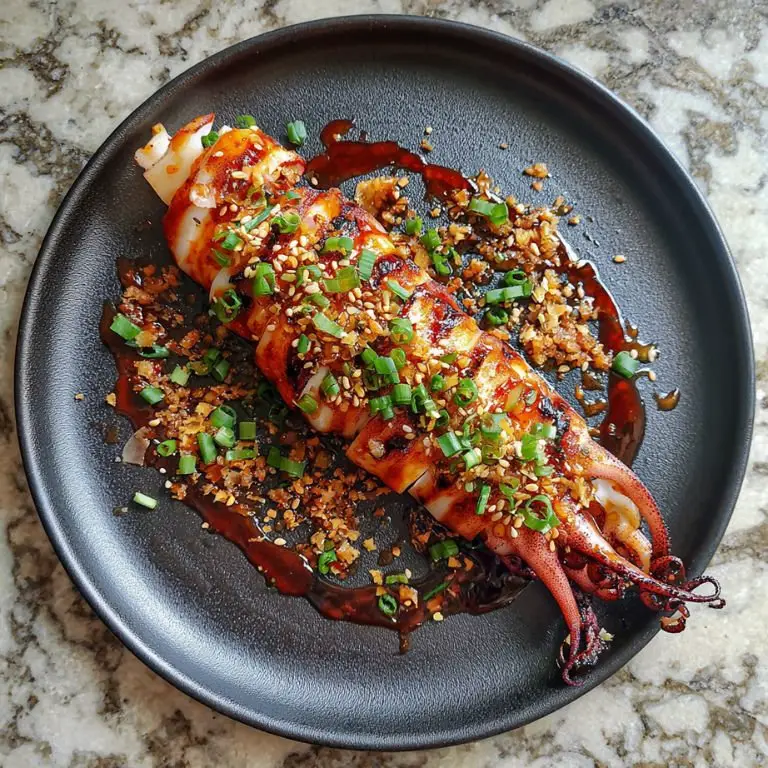Grilled squid might not be the first thing that comes to mind when you think about summer cookouts or quick weeknight dinners, but this Korean Grilled Squid with Gochujang Marinade and Sesame Oil is about to change that. This dish delivers on all fronts—smoky from the grill, spicy from the gochujang, and deeply savory from the combination of garlic, soy sauce, and toasted sesame oil. It's one of those korean recipes authentic enough to impress, but still doable for a home cook. Whether you're diving into korean seafood recipes for the first time or you're a seasoned fan of spicy squid korean dishes, this one deserves a spot on your menu.
Korean Grilled Squid with Gochujang Marinade and Sesame Oil
Prep Time 20 minutes mins
Cook Time 6 minutes mins
Marinating time 30 minutes mins
Total Time 56 minutes mins
Course Appetizer, Main Course, Side Dish
Cuisine Korean
Grill A charcoal grill gives the best smoky flavor, but a gas grill or even a stovetop grill pan will do. If you're without a grill, a very hot cast iron skillet works surprisingly well.
Mixing bowl For preparing the marinade.
Tongs To flip the squid without tearing it.
Basting brush (optional) Helpful if you want to apply more marinade while grilling.
Sharp knife To score the squid, allowing the marinade to penetrate better.
Cutting board Preferably non-wood if you’re working with seafood.
For the marinade
- 2 tablespoons gochujang Korean fermented chili paste
- 1 tablespoon soy sauce
- 1 tablespoon rice vinegar
- 1 tablespoon toasted sesame oil
- 1 tablespoon sugar white or brown
- 2 teaspoons garlic finely minced
- 1 teaspoon ginger finely grated
- 1 tablespoon mirin optional, but adds a nice sweetness
- 1 teaspoon Korean red chili flakes gochugaru, optional for more heat
- 1 tablespoon vegetable oil for grilling
For the squid
- 4 whole squid about 1–1.5 lbs total, cleaned with tentacles reserved
- Salt and pepper to taste
- Lemon wedges for serving
- Chopped scallions and sesame seeds for garnish
Optional side
- Steamed white rice or sticky rice
- Quick cucumber salad with vinegar and sesame seeds
Prepare the Squid
Start by cleaning the squid if it hasn't been pre-cleaned. Remove the innards, beak, and cartilage. Rinse well under cold water. Pat dry with paper towels.
Lightly score the body of each squid in a crisscross pattern—this not only looks beautiful when grilled but also helps it cook evenly and absorb the marinade. Leave the tentacles intact for a nice presentation.
Make the Marinade
In a medium bowl, whisk together gochujang, soy sauce, rice vinegar, sesame oil, sugar, garlic, ginger, and mirin. If you love heat, add gochugaru or extra gochujang. This base works well in other korean gochujang recipes too—try it with chicken or shrimp.
Marinate the Squid
Place the squid in a large bowl or zip-top bag. Pour the marinade over and mix well to ensure everything is coated. Let it sit for 30 minutes at room temperature. If you're short on time, even 10 minutes will work.
This marinade also pairs excellently with other korean seafood like shrimp—give it a shot with your favorite korean shrimp recipe for a mix-and-match dinner.
Preheat the Grill
Get your grill hot—medium-high heat is perfect. Oil the grates with a bit of vegetable oil to prevent sticking.
Grill the Squid
Remove the squid from the marinade and shake off excess. Place it directly on the hot grill. Grill for 2–3 minutes per side or until nicely charred and the squid curls up.
Don’t overcook—squid turns rubbery if left too long. It should be just opaque and tender. The tentacles cook a little faster, so keep an eye on them.
Serve It Up
Once grilled, transfer the squid to a serving platter. Slice into rings or serve whole. Garnish with chopped scallions, sesame seeds, and lemon wedges. Serve with steamed rice and maybe a cold Korean beer like Hite or Cass.
Pairings
This dish plays beautifully with several accompaniments:
- Sticky white rice: Classic and neutral, rice balances the heat of the marinade.
- Kimchi: Adds even more fermented tang and crunch.
- Cucumber salad: Light and crisp, it cools the palate after the spicy squid.
- Soju or makgeolli: Traditional Korean drinks that enhance the smoky, spicy profile.
- Grilled vegetables: Zucchini, onions, or bell peppers charred on the grill round out the meal.
Feeling adventurous? Pair it with squid ink pasta for a Korean-Italian fusion that nods to squid dishes across cultures.
FAQs
1. What type of squid should I use?
Fresh whole squid works best for grilling. Look for medium-sized squid (4–6 inches long). You can use frozen squid too—just thaw it completely and pat it dry. Calamari can work, but the texture and size may differ slightly.
2. Can I use squid rings instead of whole squid?
Yes, but the presentation and texture will change. Whole squid stays juicier and is less prone to overcooking. Rings cook much faster, so reduce grilling time to avoid rubbery results.
3. Is there a way to make this recipe indoors?
Absolutely. A cast iron skillet or grill pan on high heat does the trick. Open your windows or use a fan, though—it gets smoky. Broiling in the oven is another option if you're craving grilled squid on a rainy day.
4. Can I use this marinade for other seafood?
Yes! This gochujang-based marinade is fantastic with shrimp, salmon, or even scallops. It’s a go-to in many south korean recipes, especially in coastal towns where korean seafood is a culinary staple.
5. How do I know when squid is cooked?
Squid cooks quickly. You’ll know it’s done when it turns opaque, curls slightly, and has light grill marks. Overcooked squid becomes tough and chewy—err on the side of undercooking if you're unsure.
